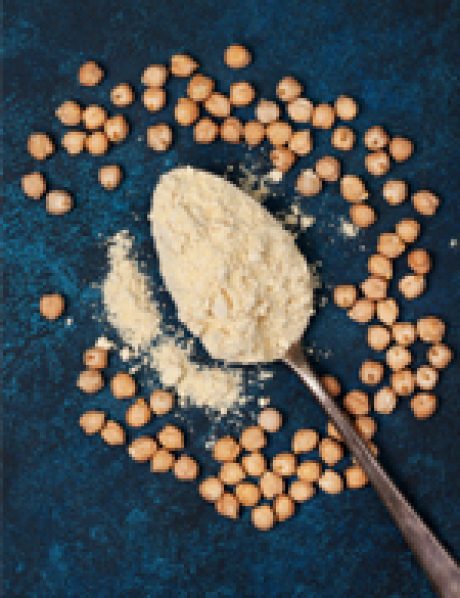Pulse Proteins

Pulse Protein Characteristics
Pulses naturally contain high levels of protein (14-39%), making them a suitable starting material for the production of plant-based proteins.1 Pulse proteins contain high levels of globulins (salt soluble proteins), which are storage proteins present at levels of 70-80%.2 Legumins (11S) and vicilins (7S) represent the majority of these globulins.
About 10-20% of pulse proteins are water-soluble albumins, consisting mainly of metabolic proteins such as enzymes, lectins protease and amylase inhibitors with the remaining protein present in minor amounts (<5%) as prolamins and glutelins2. Depending on pulse type, growing environment and processing history, there may be differences in the secondary protein structure1,2 and ratios of legumins to vicilin or globulins to albumins3. This will account for some of the variability in functional traits. Pulse proteins are generally limited in the sulfur-containing amino acids methionine, cysteine or tryptophan. Processing of pulses has been reported to modify amino acid content and protein digestibility, the extent to which depends on the type of processing.4
| Protein | Peas | Beans | Chickpeas | Lentils |
|---|---|---|---|---|
| Crude Protein
(dry basis-whole seed) | 15-32% | 18-25% | ~22% | 27.9-32.1% |
| Globulins | 65-85% | 55-80% | 42% | 51% |
| Albumins | 20-35% | 10-20% | 16% | 11-16% |
| Glutelins | 12% | 10% | 9.9% | 11% |
| Prolamins | ~1% | ~1% | 0.48% | 3.5% |
Adapted from Boye et al (2010)
Protein Formats
The protein from pulses like peas and lentils can be isolated or concentrated from the seed to be added to foods as an ingredient. Unlike soy proteins, where concentrates and isolates are defined as containing between 60-90% and ≥ 90% protein content (N x 6.25) on dry bases8, respectively, there is no common definition for protein products produced from pulses.
Typically, protein concentrates are derived from milled pulses during which the particle size is reduced and small protein particles are separated from larger starch granules. The flour is then passed through an air classifier, separating the two based on their size and density. The resulting product is concentrated in protein which may range from 29-75%5. Because the production of concentrates does not use solvents or involve a drying process, proteins produced using dry methods will retain their native protein functionality, have lower energy and water consumption and are generally less expensive6. However, the resulting products are not as pure, and other seed components present could have an effect on their functional properties.
Protein isolates are generally produced from flour that undergoes a series of wet processes which utilize the solubility properties of pulse proteins to produce a highly pure protein product with typical concentrations of >80%5. The conditions that are used during wet processing will facilitate the reduction of antinutritional factor content in the isolate, in addition to increasing the digestibility of the protein7. However, the functional properties of isolates may be reduced as a result of protein denaturation during processing.
Functionality
The functional properties of all protein concentrates and isolates largely depend on the processing method used to produce it, their physicochemical properties (i.e. amino acid profile, structure, conformation, charge, hydrophobicity, interfacial behavior and size) and the level of denaturation that occurs. The magnitude of the influence of processing history on the functional properties of proteins makes it very difficult to compare pulse protein performance across studies.
1. Vatanever, S., Tulbek, M.C., Riaz, M.N., (2020). Low and high moisture extrusion of pulse protein as plant based meat ingredients: a review. Cereal Foods World, 64 (4).
2. Shevkani, K., Singh, N., Chen, T., Kaur, A., (2019). Pulse proteins: secondary structure, functionality and applications. Food Research International, 56: 2787-2798.
3. Boye, J., Zare, F., Pletch, A. (2010). Pulse proteins: processing, characterization, functional properties and applications in food and feed. Food Research International, 414-431. https://doi.org/10.1016/j.foodres.2009.09.003
4. Cargo-Froom, C., Shoveller, A., Marinangeli, C.P.F., Columbus, D.A. (2020). Methods for processing pulses to optimize nutritional functionality and maximize amino acid available in foods and feeds. Cereal Foods World, 65(6). https://doi.org/10.1094/CFW-65...
5. Arntfield, S.D. and Maskus, H.D. 2011. Peas and other legume proteins. G.O. Phillips and P.A. Williams. Handbook of Food Proteins. Cambridge : Woodhead Publishing, 2011. https://doi.org/10.1533/9780857093639.233
6. Pelgrom, P.J.M., Visser, A.M., Boom, R.M., Schutyser, M.A.O., (2013). Dry fractionation for production of pea protein concentrates. Food Research International, 53: 232- 239. https://doi.org/10.1016/j.foodres.2013.05.004
7. Vogelsang-O’Dwyer, M., Joehnke, I.L., Sorensen, M.S., Peterson, J.C., Bez, J., Detzel, A., Busch, M., Krueger, M., O’Mahony, J.A., Arendt, E.K., Zannini, E. (2020). Comparison of faba bean protein ingredients produced using dry fractionation and isoelectric precipitation: tech-functional, nutritional and environmental performance. Foods, 9 (322): 1-24.
8. CODEX. 1989. Standard for Soy Protein Products (CODEX STAN 175-1989). Codex Alimentarius Commission. [Online] 1989. [Cited: 9 1, 2020.] http://www.fao.org/fao-who-codexalimentarius/codex-texts/list-standards/en/.

